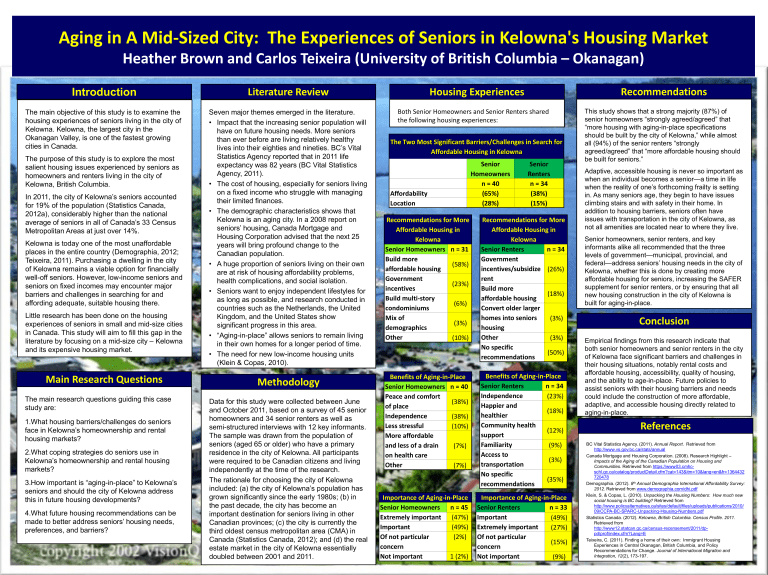The experiences of seniors in Kelowna`s housing market

Aging in A Mid-Sized City: The Experiences of Seniors in Kelowna's Housing Market
Heather Brown and Carlos Teixeira (University of British Columbia – Okanagan)
Introduction
The main objective of this study is to examine the housing experiences of seniors living in the city of
Kelowna. Kelowna, the largest city in the
Okanagan Valley, is one of the fastest growing cities in Canada.
The purpose of this study is to explore the most salient housing issues experienced by seniors as homeowners and renters living in the city of
Kelowna, British Columbia.
In 2011, the city of Kelowna’s seniors accounted for 19% of the population (Statistics Canada,
2012a), considerably higher than the national average of seniors in all of Canada’s 33 Census
Metropolitan Areas at just over 14%.
Kelowna is today one of the most unaffordable places in the entire country (Demographia, 2012;
Teixeira, 2011). Purchasing a dwelling in the city of Kelowna remains a viable option for financially well-off seniors. However, low-income seniors and seniors on fixed incomes may encounter major barriers and challenges in searching for and affording adequate, suitable housing there.
Little research has been done on the housing experiences of seniors in small and mid-size cities in Canada. This study will aim to fill this gap in the literature by focusing on a mid-size city – Kelowna and its expensive housing market.
Main Research Questions
The main research questions guiding this case study are:
1.What housing barriers/challenges do seniors face in Kelowna’s homeownership and rental housing markets?
2.What coping strategies do seniors use in
Kelowna’s homeownership and rental housing markets?
3.
How important is “aging-in-place” to Kelowna’s seniors and should the city of Kelowna address this in future housing developments?
4.What future housing recommendations can be made to better address seniors’ housing needs, preferences, and barriers?
Literature Review Housing Experiences
Seven major themes emerged in the literature.
• Impact that the increasing senior population will have on future housing needs. More seniors than ever before are living relatively healthy lives into their eighties and nineties. BC’s Vital
Statistics Agency reported that in 2011 life expectancy was 82 years (BC Vital Statistics
Agency, 2011).
• The cost of housing, especially for seniors living on a fixed income who struggle with managing their limited finances.
• The demographic characteristics shows that
Kelowna is an aging city. In a 2008 report on seniors’ housing, Canada Mortgage and
Housing Corporation advised that the next 25 years will bring profound change to the
Canadian population.
• A huge proportion of seniors living on their own are at risk of housing affordability problems, health complications, and social isolation.
• Seniors want to enjoy independent lifestyles for as long as possible, and research conducted in countries such as the Netherlands, the United
Kingdom, and the United States show significant progress in this area.
• “Aging-in-place” allows seniors to remain living in their own homes for a longer period of time.
• The need for new low-income housing units
(Klein & Copas, 2010).
Both Senior Homeowners and Senior Renters shared the following housing experiences:
The Two Most Significant Barriers/Challenges in Search for
Affordable Housing in Kelowna
Affordability
Location
Senior
Homeowners n = 40
(65%)
(28%)
Senior
Renters n = 34
(38%)
(15%)
Recommendations for More
Affordable Housing in
Kelowna
Senior Homeowners n = 31
Build more
(58%) affordable housing
Government
(23%) incentives
Build multi-story
(6%) condominiums
Mix of
(3%) demographics
Other (10%)
Recommendations for More
Affordable Housing in
Kelowna
n = 34 Senior Renters
Government incentives/subsidize rent
(26%)
Build more affordable housing
Convert older larger homes into seniors housing
Other
No specific recommendations
(18%)
(3%)
(3%)
(50%)
Methodology
Data for this study were collected between June and October 2011, based on a survey of 45 senior homeowners and 34 senior renters as well as semi-structured interviews with 12 key informants.
The sample was drawn from the population of seniors (aged 65 or older) who have a primary residence in the city of Kelowna. All participants were required to be Canadian citizens and living independently at the time of the research.
The rationale for choosing the city of Kelowna included: (a) the city of Kelowna’s population has grown significantly since the early 1980s; (b) in the past decade, the city has become an important destination for seniors living in other
Canadian provinces; (c) the city is currently the third oldest census metropolitan area (CMA) in
Canada (Statistics Canada, 2012); and (d) the real estate market in the city of Kelowna essentially doubled between 2001 and 2011.
Benefits of Aging-in-Place
Senior Homeowners n = 40
Peace and comfort of place
(38%)
Independence
Less stressful
More affordable and less of a drain on health care
Other
(38%)
(10%)
(7%)
(7%)
Importance of Aging-in-Place
Senior Homeowners n = 45
Extremely important (47%)
Important
Of not particular concern
Not important
(49%)
(2%)
1 (2%)
Benefits of Aging-in-Place
Senior Renters n = 34
Independence (23%)
Happier and healthier
(18%)
Community health support
(12%)
Familiarity
Access to transportation
No specific recommendations
(9%)
(3%)
(35%)
Importance of Aging-in-Place
Senior Renters n = 33
Important (49%)
Extremely important (27%)
Of not particular
(15%) concern
Not important (9%)
Recommendations
This study shows that a strong majority (87%) of senior homeowners “strongly agreed/agreed” that
“more housing with aging-in-place specifications should be built by the city of Kelowna,” while almost all (94%) of the senior renters “strongly agreed/agreed” that “more affordable housing should be built for seniors.”
Adaptive, accessible housing is never so important as when an individual becomes a senior —a time in life when the reality of one’s forthcoming frailty is setting in. As many seniors age, they begin to have issues climbing stairs and with safety in their home. In addition to housing barriers, seniors often have issues with transportation in the city of Kelowna, as not all amenities are located near to where they live.
Senior homeowners, senior renters, and key informants alike all recommended that the three levels of government —municipal, provincial, and federal —address seniors’ housing needs in the city of
Kelowna, whether this is done by creating more affordable housing for seniors, increasing the SAFER supplement for senior renters, or by ensuring that all new housing construction in the city of Kelowna is built for aging-in-place.
Conclusion
Empirical findings from this research indicate that both senior homeowners and senior renters in the city of Kelowna face significant barriers and challenges in their housing situations, notably rental costs and affordable housing, accessibility, quality of housing, and the ability to age-in-place. Future policies to assist seniors with their housing barriers and needs could include the construction of more affordable, adaptive, and accessible housing directly related to aging-in-place.
References
BC Vital Statistics Agency. (2011). Annual Report . Retrieved from http://www.vs.gov.bc.ca/stats/annual
Canada Mortgage and Housing Corporation. (2008). Research Highlight –
Impacts of the Aging of the Canadian Population on Housing and
Communities . Retrieved from https://www03.cmhcschl.gc.ca/catalog/productDetail.cfm?cat=143&itm=10&lang=en&fr=1364432
720478
Demographia. (2012). 8 th Annual Demographia International Affordability Survey:
2012 . Retrieved from www.demographia.com/dhi.pdf
Klein, S. & Copas, L. (2010). Unpacking the Housing Numbers: How much new social housing is BC building?
Retrieved from http://www.policyalternatives.ca/sites/default/files/uploads/publications/2010/
09/CCPA-BC-SPARC-Unpacking-Housing-Numbers.pdf
Statistics Canada. (2012). Kelowna, British Columbia. Census Profile. 2011 .
Retrieved from http://www12.statcan.gc.ca/census-recensement/2011/dppd/prof/index.cfm?Lang=E
Teixeira, C. (2011). Finding a home of their own: Immigrant Housing
Experiences in Central Okanagan, British Columbia, and Policy
Recommendations for Change. Journal of International Migration and
Integration , 12 (2), 173-197.





